|
AHEAD of us heading out of Red Square was a stone multi lane bridge crossing over the Moskva River. This river starts to the west about 140 kilometres upstream and works its south eastward into the Oka River 360 kilometres downstream. From there it flows into the Volga which flows into the Caspian Sea over 3000 kilometres downstream from here. This part of the river usually freezes over sometime between November and December. It remains frozen until it starts thawing in late March.
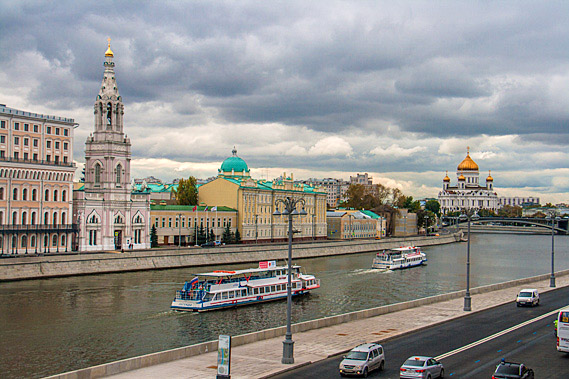 |
Moskva River |
Several passenger boats were going up and down the grey waters of the river, ruffled by the chill wind but otherwise flowing calmly between its banks with footpaths on either side. The stone buildings on the other side of the river stood several storeys high. A couple of the buildings had bluish green copper domes adding to the grey dreariness of the cityscape.
 |
Red Square |
Looking downstream I could see the golden domes of a large white cathedral, the Cathedral of Christ the Saviour, which Pavel mentioned we were heading towards.
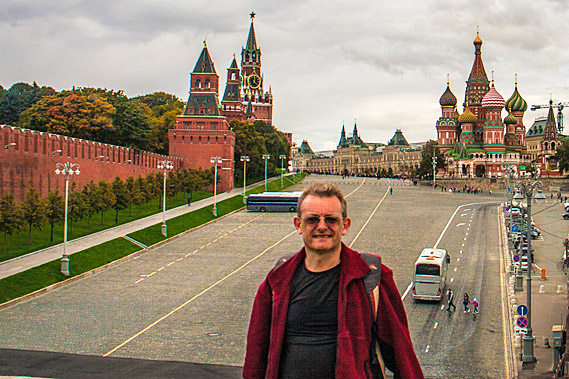 |
Posing on the bridge |
We began crossing the bridge beside the busy Bolshoy Moskvoretskiy most road running past the dark red wall of the Kremlin, looking from this side like a formidable fortress with its rows of round towers rising above the wall.
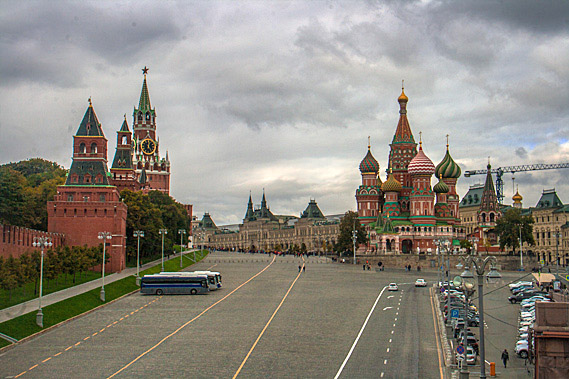 |
Red Square |
A little further out on the bridge we reached a flat area jutting out from the walkway to provide a clear view back over Red Square, now with St Basil’s Cathedral standing dominant along with the towers of the Kremlin over the opposite side of Red Square. The GUM was visible in the distance over the low hill. I posed at this lookout for a few pictures before we headed further out above the river.
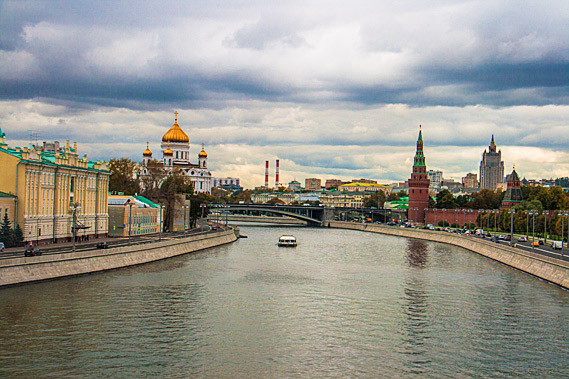 |
Moskva River |
Pavel mentioned the seven sisters, tall buildings we could see from here. These are Stalin’s high rises built between 1947 and 1953, in a style cross between Russian Baroque and Gothic. The reasons behind the construction of these buildings was a closely guarded secret by Stalin, common in his decisions, so much about them is shrouded in mystery. They are all roughly triangular in shape having different steps heading up to a spire at the top. They are distinctive parts of the Moscow skyline, as most stand out above their surrounding buildings.
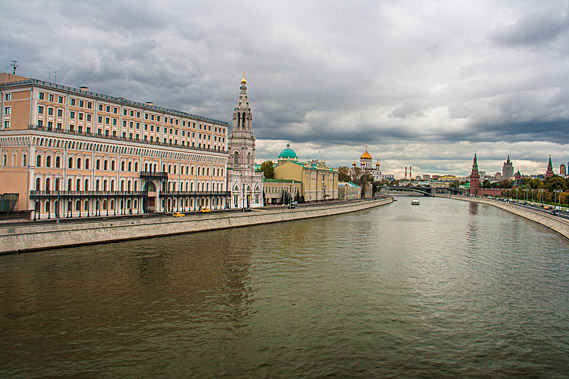 |
Moskva River |
As we headed across the river, we could see more of the Kremlin, with the gold domes on top of creamy white buildings towering within the complex sealed by the red wall fortress. The centrepiece was an ostentatious green copper roofed large building covered in white and trimmed in gold, this was the Grand Kremlin Palace, the official residence of Vladimir Putin. From here the world’s largest nation is run.
 |
The Kremlin |
The site of the Kremlin has been constantly occupied since the Finno-Uguric peoples arrived in the 2nd century BC. The Slavs took over the site in the 11th century calling this hill where the two rivers meet the Grad of Moscow. This name remained until 1331 when it was renamed The Kremlin, meaning a fortress within a city. The new name reflected the wall built in oak around it to better protect it from invasion. The Grad of Moscow had been destroyed by the Mongols nearly 100 years earlier. Over the following decades, the temporary oak wall was gradually rebuilt using limestone to improve The Kremlin’s defences.
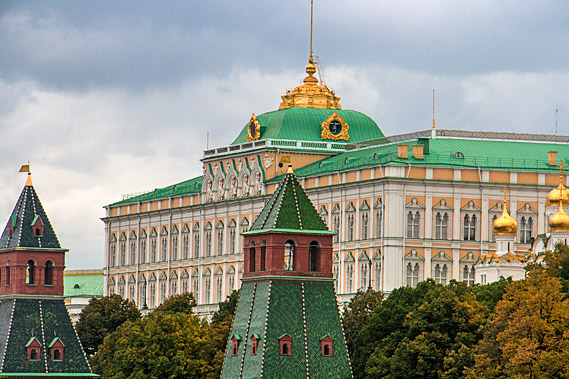 |
Kremlin Palace |
Beside the presidential palace were the towering gold domes of the Ivan the Great Bell Tower, the Cathedral of the Annunciation, the Cathedral of the Archangel Michael and the Dormition Cathedral, the latter being the main church of Moscow where the Tsars have always been crowned in the centuries following its completion in 1479.
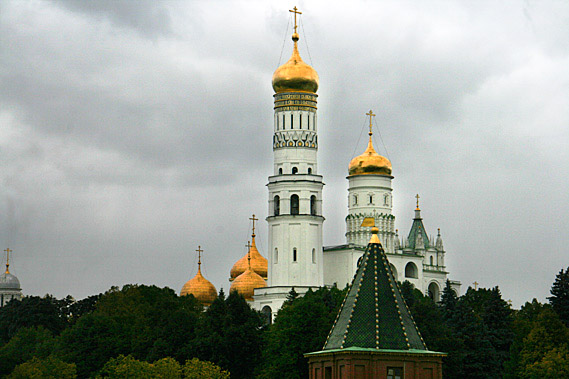 |
Cathedral spires |
Looking beyond the complex, I could see a number of towering high-rise glass buildings marking Moscow’s financial district about four kilometres away. It is a 60-hectare site where construction started in 1992. Now it contains Europe’s three tallest buildings. Six buildings stand over three hundred metres tall, with the highest at 374m.
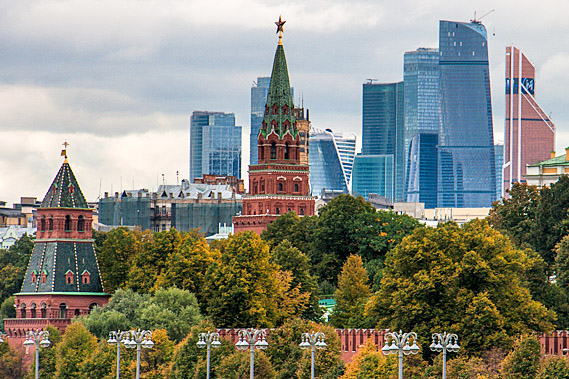 |
Moscow's financial district |
Upon crossing the river, we climbed down to the walkway following the river towards the cathedral. Initially we passed buildings, crossing the small island to the channel on the other side. This opened out to a large long pond with the path separating it from the river.
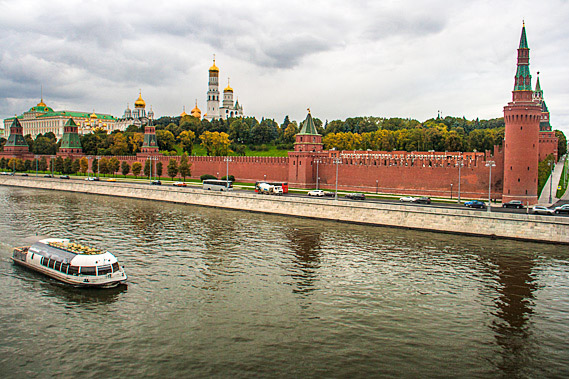 |
The Kremlin |
In the middle of the pond were a row of water fountains pushing water up to five or six metres. Some fountains were small and others were tall, depending on the direction the jets were pumping the water. Along the footpath were poles with small tree structures covered in padlocks where lovers would tie the knot. Apparently locks put on the railing to the river or pond were removed, encouraging people to put them on these structures. The structures were thickly covered in the locks now with little room to add any new ones.
 |
Fountain |
The river diverted off to the right as the stone path led into the leafy Bolotnaya Square. Some of the trees were already yellow from the autumn, whilst most of the others were just starting to lose their colours as the trees were preparing to sleep for the autumn and long winter.
 |
Many padlocks |
We walked into the square reaching a large cobblestone platform with two full sized bronze children playing in the middle with the black statues of numerous rather evil looking people surrounding them. The sculpture was called “Children are the victims of adults’ vices”, created by the world famous Mihail Chemiakin. Although born in Russia, he moved to Paris to work in 1971, then moved to New York in 1981, where he has been based since. He has created numerous well-known monuments around the world.
 |
"Children are the victims of adults' vices" |
This statue had two children surrounded by thirteen adults. He created it in August and September of 2001 gifting it to the city of Moscow as an allegory of the fight against the global evil. He wanted to send the message as a call for action to save the current and future generations, to save Russia’s future.
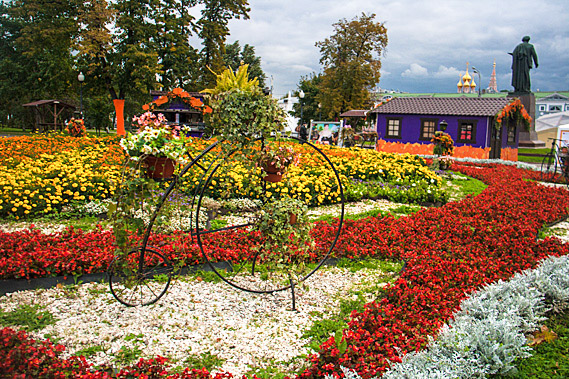 |
Flower garden with penny farthing |
The sculpture faced out onto a long section of lawn and flower beds. The flowers were giving their last blooms of colour before winter. On either side of the garden was paving and seats facing into it. We walked along one side of the garden heading towards some distant government buildings.
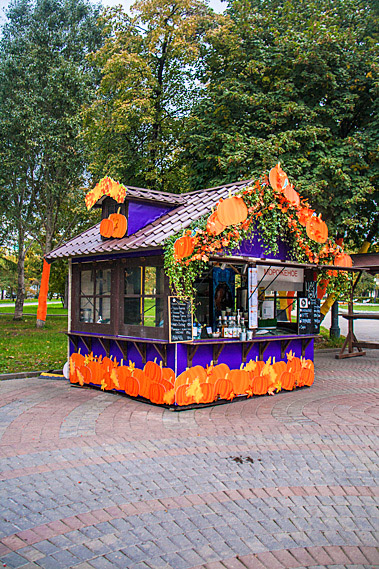 |
Harvest stall |
Eventually we reached the end of the long garden, reaching a large round garden magnificently coloured with the autumn flowers. A penny farthing decorated with pots sat in the garden. A few other bikes decorated with pots of flowers surrounded the garden.
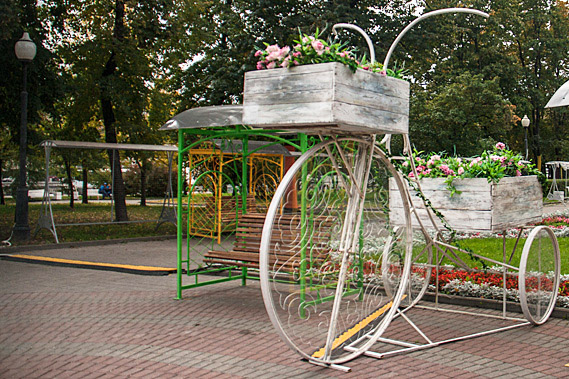 |
Tricycle |
Surrounding the garden were several small roofed buildings set up as stalls as part of the harvest festival. Each one sold different products. We had a close look at one selling different types of honey. A few of the surrounding trees had brightly coloured wrapping wrapped around their trunks, perhaps concealing the cables to lights set up within the trees. This would be a very interesting spectacle by night.
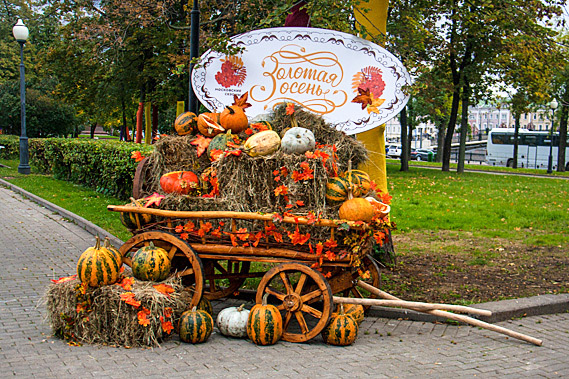 |
Pumpkin cart |
Walking past the garden, we passed a few curious metal cylinder sculptures following some more rectangular gardens in between the trees. The gardens were still very colourful but that would change over the coming weeks with the first of the winter snow shortly to arrive.
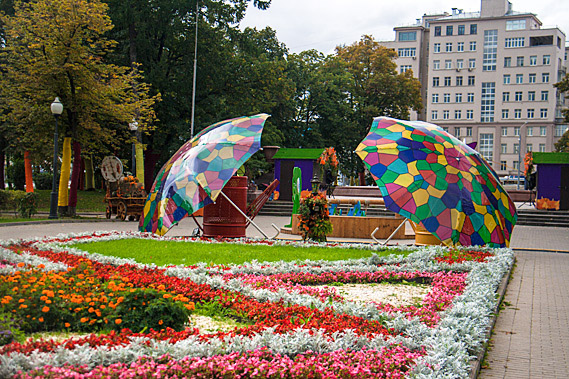 |
Flower garden |
We passed some large brightly coloured umbrellas and a wooden cart full of vegetables beautifully displayed before reaching a large fountain surrounded by more stalls.
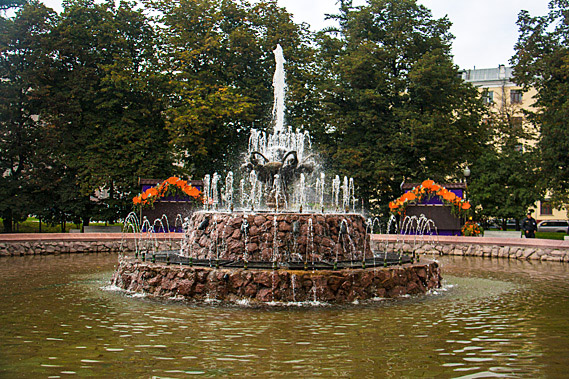 |
Fountain |
Passing the fountain, the square cleared into a large paved area with another busy road nearby. Across the road was a large government building. Unlike the other government buildings we had seen so far, this wasn’t just a large stone box. Instead it had numerous corners and alcoves. It was a very drab building though and I wouldn’t have thought anything of it.
 |
Building with secret passages |
Pavel said this building had a very interesting history. It was occupied by numerous bureaucrats, but there were conspiracy stories of them suddenly disappearing out of thin air. It was believed the building had a network of secret corridors through which people could move along, enter rooms, capture naughty bureaucrats and take them away making it seem they have disappeared.
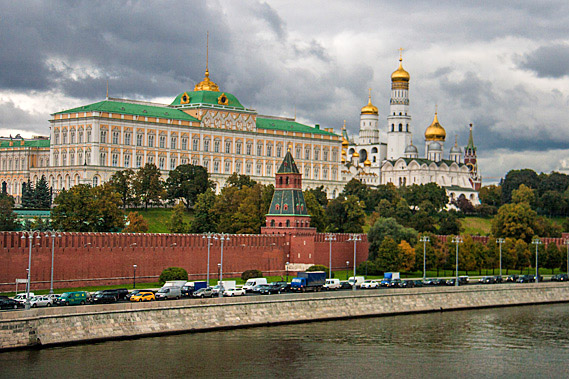 |
The Kremlin |
We didn’t cross over to the government building. Perhaps Pavel was worried about me disappearing without a trace here half a world away from home. The road crossed the river along the Bolshoy Mamenny most road. We followed the footpath heading across the river, having reached the other end of the Kremlin getting our best view yet from a viewing platform on the bridge.
|
